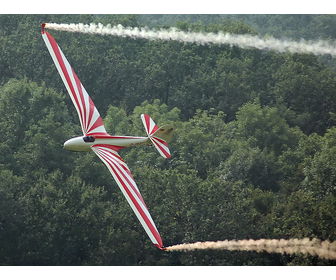DFS Habicht

Picture has been licensed under a GFDL license.
Original source: Own work Author Kogo Permission (Reusing this file) GFDL
Author: Kogo Permission (Reusing this file) GFDL
Original source: Own work Author Kogo Permission (Reusing this file) GFDL
Author: Kogo Permission (Reusing this file) GFDL
The DFS Habicht was designed in 1936 by Hans Jacobs as an unlimited aerobatic sailplane with support provided by the Deutsche-Forschungsanstalt für Segelflug. Four planes were made available for the Olympic Games of 1936 where the evolutions of the Habicht over and literally inside the Olympic stadium enthralled spectators. The flight qualities of the Habicht were praised by pilots including Hanna Reitsch.
The DFS Habicht (German: "Hawk") was designed in 1936 by Hans Jacobs
as an unlimited aerobatic sailplane, with support provided by the
Deutsche-Forschungsanstalt für Segelflug.1
DFS Habicht was designed in
1936 by Hans Jacobs as an unlimited aerobatic sailplane, with support
provided by the Deutsche-Forschungsanstalt für Segelflug.2
Made by Deutsche Forschungsanstalt für Segelflug.
The DFS Habicht (Hawk) was a fully aerobatic glider that was
designed in Germany in 1936, in fact in the same year, 4 of these
3
Empty Weight Lb
550
Wing Area Sqm
16
Designer
Hans Jacobs
Aspect Ratio
12
Glide Ratio
21
Gross Weight Lb
770
Sink Rate Ms
1
Crew
One pilot
Empty Weight Kg
250
Gross Weight Kg
350
Span M
14
Sink Rate Ftmin
160
Manufacturer
Max Speed Mph
160
Max Speed Kmh
250
Span In
7
Span Ft
44
Wing Area Sqft
170
Met Or Eng
met
Length Ft
21
Length In
7
Length M
7
Category
